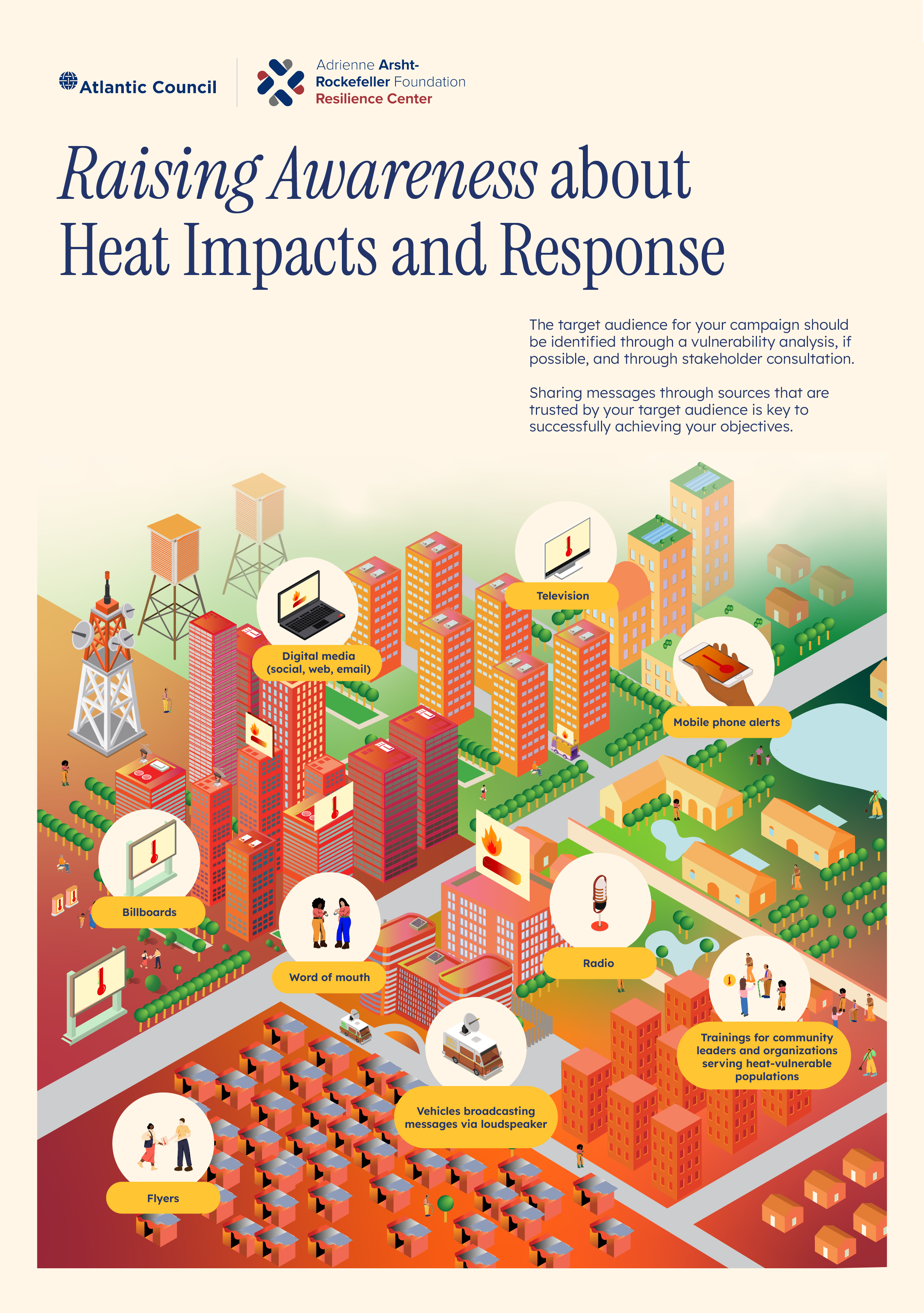Objective
Welcome to the Develop an Education and Engagement Strategy module! Identifying and engaging with community members and in particular communities with low trust in government is an essential component of a strategy to raise awareness about extreme heat’s impacts and protective measures.
Develop education and engagement strategies that establish early and ongoing communication channels with community members and organizations. This will create opportunities to co-develop goals, values, and priorities for plans and projects with affected communities. Language, age, gender, race and ethnicity, geographic location, religion, among other identities should be considered when creating an inclusive education and engagement strategy. After developing the strategy, you should continue to adapt and improve it over time based on its results and new information.
Essential Actions, Outputs, and Outcomes from this Module
Actions
-
Identify and map your target audiences for the strategy based on a stakeholder analysis and/or temperature and vulnerability analysis (see Assess Heat Risk Awareness and Identify Heat-Related Vulnerabilities and Impacts).
-
In consultation with heat-affected communities, evaluate which mix of communication modes (e.g., radio, billboards, television, flyers, social media), languages and messengers will be most effective in reaching your target audience.
-
Develop a heat campaign or heat warnings using best practices on heat safety, which provides tailored guidance for heat-vulnerable populations. The campaign or warnings should ideally be co-developed with target audiences to ensure maximum buy-in.
-
Launch the campaign or alert system ahead of the heat season, with an increase in outreach during extreme heat events. Ideally launch with partners who will assist with or lead on dissemination of messages and integrate the campaign or system into existing response and education channels.
Outputs
-
Document identifying target audience for a heat campaign or heat alerts and ways to reach them (e.g., trusted messengers).
-
Finalized heat awareness materials (e.g., social media posts, ad visuals, posters, flyers).
Outcomes
-
Key stakeholders who should be included in the efforts to understand and address the problem of heat are identified.
-
A path to a collaborative, inclusive, and fair engagement and co-development processes.
-
Clarity in the role communication and education play in addressing heat-related harms.
-
Effective communication tools targeting identified stakeholders are developed.
Overview
The Essential Actions, Outputs, and Outcomes include the core elements of the more comprehensive approach described throughout the rest of the module. We know that time, resources, and capacity can limit the breadth and depth of interventions you undertake. Simply beginning to explore these modules and consider what solutions are appropriate for your context is a critical step toward building your jurisdiction’s heat resilience. At any point, reach out to Arsht-Rock using the contact form at the bottom of the page with questions and comments.
The importance of an education and engagement strategy
Awareness of extreme heat as a health risk is often alarmingly low, particularly among populations that are at greatest risk due to heat. Often, individuals aged 65 and older and other at-risk people see others as susceptible to heat illness or death, but not themselves. A heat education and engagement strategy should:
- Increase levels of awareness among the public and key stakeholders, particularly the communities who are the most likely to be harmed.
- Provide clear advice and actionable guidance on how the public and service/information providers can protect themselves and/or others.
- Take a multi-stakeholder approach and utilize a variety of information types and channels to reach audiences effectively.
- Highlight available resources and services to help people prepare for and respond to dangerous heat.
Heat-related communications are not solely used during period of hot temperatures, though the quantity and variety of communications may increase with heat waves. They can be issued year-round (to increase general heat awareness), ahead of and during your heat season, and ahead of or during heat events to further reinforce good preparedness and reinforce awareness of what to do when the weather is dangerously hot.
Elements of an education and engagement strategy
- Clear goals and objectives around the target audience and outcomes of heat risk communication.
- Identified “plan of action” that includes stakeholders, communications channels and vehicles, such as spokespersons.
- A timeline that considers the most effective moments or phases in which to communicate to the public in advance of and during heat waves.
- Consideration of existing communications plans and how to integrate heat risk communications to avoid contradictory messaging.
- Risk communication products and materials that are accessible, credible, actionable, and personally relevant.
- Integration with heat risk and impact reduction projects, such as opening of cooling centers, early warning alerts, and other social programs.
Resources
Communicating Heat Risk
- Global
Experiences from C40’s Cool Cities Network. For a guide and examples on communicating heat risk, see pages 2-3 and 5-11 of Communicating Heat Risk produced by C40.
Heat Communication Guide for the Cities in South Asia
- South Asia
For a guidance note focused on the key components (access, relevance, understanding, and action) of an effective public communication plan in the context of cities in South Asia, see Heat Communication Guide for the Cities in South Asia from the Climate and Development Knowledge Network.
Communicating the Health Risks of Extreme Heat Events
- Canada
For a holistic guide on heat-related communications, see Communicating the Health Risks of Extreme Heat Events: Toolkit for Public Health and Emergency Management Officials produced by Health Canada.
Identifying audience and communication channels
The target audience should be drawn from either a pre-existing vulnerability assessment or should be identified through the output of the Identify Heat-Related Vulnerabilities and Impacts and Assess Heat Risk Awareness modules.
Broadly, the strategy can target four levels of audiences:
- Heat-vulnerable individuals
- Social networks
- Organizations and agencies, departments, and ministries
- Communities and/or societies

Socially isolated community members
Socially isolated individuals are at greater risk of heat-related illness or death during heat waves due to a lack of family and friends who can check in on them.

Non-native language speakers
Non-native language speakers may not be able to access the latest heat warnings and information on staying safe during heat waves.

Low-income communities
Low-income communities are often geographically clustered in areas that are most exposed to extreme heat, with housing conditions that exacerbate heat exposure, and may lack resources to keep themselves cool.

Communities with low levels of trust in government
Marginalized communities or those that have had negative experiences with government-provided information or services in the past may be less likely to trust or take action on heat risk communication coming from government sources.
Understanding how your audiences transmit and receive information is key to reaching them effectively. Identify and partner with the leaders, organizations, and agencies that interact with heat-vulnerable populations, such as health care providers, schools, and businesses, to ensure that you are using the most effective channels and risk communication messaging. Communication channels between city authorities, intermediaries (e.g., local media, NGOs, community leaders), and communities can include:
- Social media
- Television
- Websites
- Radio
- Word of mouth
- Text message (SMS, WhatsApp) alerts and phone calls
- Newspapers
- Flyers
- Messaging specifically for trusted/influential community organizations
- Public announcements (e.g., broadcasted from vehicles or loudspeakers)
- Heat “hotlines” that the public can call for information
Quantitative data on which communication channels are commonly used can be sourced through community surveys, telecom governing bodies, universities, and private research agencies while NGOs and community leaders can provide more qualitative data. Consider also how audience literacy, language fluency, financial access (e.g., to the internet or television) and level of trust in various communication channels can moderate access to information.
Resources
Karachi Heat Action Plan
- Pakistan
For an example of a city’s heat communications plan and samples of warning messages and graphics, see pages 22 and 44-56 of the Karachi Heat Action Plan: A Guide to Extreme Heat Planning and Response.
Ahmedabad Heat Action Plan
- India
For a map of communication channels and key pre-, during, and post-heat season communications undertaken by the city of Ahmedabad, see page 3 of the Ahmedabad Heat Action Plan.
Be a Buddy: A Community-Based Climate Resiliency Model
- United States
For an example of a community-based heat risk communication and emergency response program, explore the Be a Buddy program in New York City.
Launching a heat awareness campaign or alert system
Ideally, campaigns should begin in advance of a heat season to have sufficient lead time to make people aware of how to protect themselves and others during the upcoming summer. Heat alerts and warnings should also be tested ahead of the heat season to ensure that they are working correctly and reaching your target audience.
Heat-related communications should be consistent across channels and timing (i.e., during cooler months vs. during a heat wave). They should ideally also complement other public health messages being issued by the local government and other stakeholders, with a mix of written and visual formats depending on the channel.
Heat-related communications content can include:
- Weather forecast
- Areas which will be most affected
- Potential impacts
- Advice on what actions to take
When developing messages, consider whether they (adapted from Health Canada [2011]):
- Identify and test key messages and required actions
- Communicate clearly
- Motivate your audience
- Use vivid and appropriate images wherever possible
- Build trust by providing evidence and acknowledge any lack of certainty
- Avoid technical jargon, condescending phrases, or promises/guarantees
Resources
Heat Toolkit Campaign Materials
- Global
For posters, social media assets, and videos available in English, Bengali, and Nepali that you can use to inform people about how to protect themselves during heat waves, see the Global Disaster Preparedness Center’s Heat Toolkit Campaign Materials.
Arsht-Rock #HeatSeason Campaign
- Global
For social media images and copy on the impacts of heat and how cities can protect their residents, available in English, French, German, Spanish, and Greek, see Arsht-Rock’s #HeatSeason campaign materials.
Protecting Children from Heat Stress
- Global
For public health messages and information tailored to pregnant women, children, and infants within the “B.E.A.T. the Heat” communication framework, see page 18 of UNICEF’s technical note Protecting Children from Heat Stress.
Heat Health Communication Message Review Tool
- Canada
For a simple checklist for reviewing your heat warning and education messages, among other resources, see page 39 of Communicating the Health Risks of Extreme Heat Events: Toolkit for Public Health and Emergency Management Officials produced by Health Canada.
Extreme Heat Toolkit
- United States
For talking points that government officials could use about extreme heat and guidance on message mapping, see pages 10-12 of the Extreme Heat Toolkit produced by the Wisconsin Climate and Health Program in the United States.
Congratulations! You’ve completed Develop an Education and Engagement Strategy.
Review the Essential Actions, Outputs, and Outcomes from this Module or proceed to the next module.






